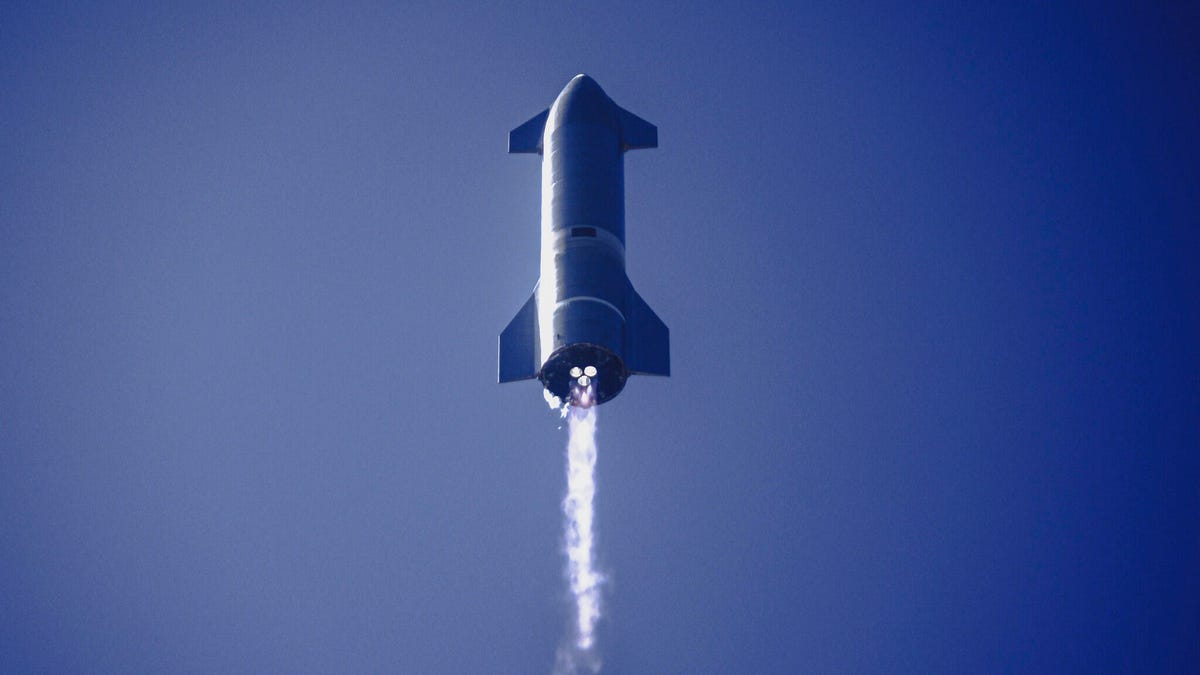SpaceX Starship SN10 launch: How to watch rocket prototype fly today
Elon Musk's Mars rocket lit up for a second on Wednesday but didn't get off the ground. A second launch attempt is coming.

Starship SN9 in flight.
The SpaceX Starship rocket prototype, SN10, ignited its engines for a split second on Wednesday afternoon, but an issue with the launch procedure triggered an automatic abort. Elon Musk, SpaceX CEO, said the rocket had a "slightly conservative high thrust limit" but the team would recycle propellant and try again. The company is now planning to try again at around 2:30 p.m. PT and if you want to watch live, we've got you covered.
These prototype tests have been coming extremely quickly for SpaceX's Starship program. Only weeks after its predecessor SN9 flew high and then crash-landed on Texas' Gulf Coast, SN10 will attempt to improve on that performance. Continue to check back here as we'll embed the livesteam for the next attempt. Alternatively, you can keep one eye on the SpaceX website, which begins a stream about five minutes prior to flight.
SN10 and SN9 are the latest iterations of SpaceX and Elon Musk's Starship prototypes that the company has been developing in full view at its facility in Boca Chica, Texas (or Starbase, as it might be known soon). Musk has promised that the next-generation rocket will be capable of revolutionary point-to-point travel around the globe, as well as sending civilians to the moon, Mars and beyond.
Over the past few years, Starship prototypes have progressed from making short, low-altitude "hops" to high-altitude flight demonstrations. The past two serial numbers, SN8 and SN9, have both flown to altitudes comparable to where commercial jets cruise, but then came in for explosive hard landings.
Musk had warned in advance of the tests that he expected such "rapid unscheduled disassembly" events to be part of the development process.
SpaceX SN8 flew high and landed hard.
Following the flight and crash landing of SN8 in December, the follow-up flight of SN9 suffered a series of delays throughout January. It was revealed that SN8 had been launched without all required approvals from the Federal Aviation Administration, and a kind of staring contest developed as the FAA then took its time to grant the launch license for SN9.
In the end, the FAA was satisfied with the safety precautions for the test flight and SN9 finally flew on Feb. 2. After its fiery return to Earth that afternoon, the FAA announced it would be investigating the landing "mishap."
On Feb. 19, an FAA spokesperson said via email that the agency has closed the investigation into the landing mishap, "clearing the way for the SN10 test flight pending FAA approval of license updates."
"The SN9 vehicle failed within the bounds of the FAA safety analysis. Its unsuccessful landing and explosion did not endanger the public or property. All debris was contained within the designated hazard area. The FAA approved the final mishap report, including the probable causes and corrective actions."
As of Feb. 22, The Washington Post's Christian Davenport was reporting that the FAA launch license has been granted, paving the way for SN10 to launch following a static test fire.
That test happened Tuesday, and SpaceX wasn't quite satisfied with the results. One of SN10's Raptor engines was swapped out and another test fire was completed Thursday. A launch Friday was ruled out, and over the weekend SpaceX also opted not to try on Monday.
Check back here for updates once SN10 is finally ready to fly (again). We'll also include a livestream link here when it becomes available.
Follow CNET's 2021 Space Calendar to stay up to date with all the latest space news this year. You can even add it to your own Google Calendar.

